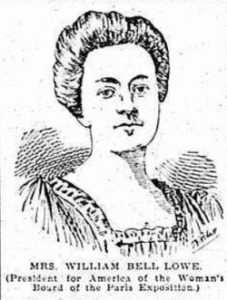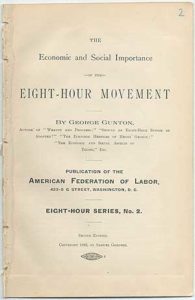

Tagged: gender, labor, legal history, Progressive Era
by Stephen Leccese
“What a scoundrel!” my mom exclaimed as I told her the following story. This is not a typical reaction when I talk about my work–my research on economic theory and policy is not exactly a scandal-ridden field for non-historians. So when I came across a story of divorce and abandonment involving economist George Gunton, one of my research subjects, my work received some personal background that I didn’t expect. In piecing together newspaper reports and letters that George’s wife Amelia sent to Columbia University professor Edwin Seligman, I found out that Gunton had been illegally married to two women at the same time, deserting Amelia and leaving her nearly destitute. Amid all my reading about economic theory, it was striking to discover something more personal, and the affair reveals the inconsistencies one often finds between reformers’ public and private lives.
Divorce and family desertion caused anxiety for many progressive reformers at the turn of the century. By 1920, several states had enacted harsher penalties on marital deserters. Earlier in the century, however, enforcement of desertion laws was erratic. As the legal process proceeded slowly, women who depended on their husband’s income suffered most. These tensions came together in the case of George Gunton’s desertion of Amelia in 1903.

Portait of George Gunton by Austa Densmore Sturdevant (1894). Courtesy of www.nyhistory.org/exhibit/george-gunton-1845-1919
At that time, Gunton was one of New York City’s prominent citizens. An English immigrant who had started working in Lancashire textile mills at age eleven, he first settled in Massachusetts in 1874 and then arrived in New York in 1884. He transitioned into the role of a public speaker, author, and educator, eventually opening his own school in 1891, the Institute of Social Economics. Gunton had a history of promoting women’s rights and bragged that half of the institute’s members were women.[1] The institute’s success made Gunton a local celebrity and drew support from powerful Republican politicians like Theodore Roosevelt and House speaker Thomas B. Reed. These political connections made the next few years the height of Gunton’s career. Then in 1906, news broke about a scandal involving Gunton and his former wife Amelia.

Courtesy of https://www.findagrave.com/memorial/115802159/rebecca-lowe
George and Amelia had married in 1887. This was his second marriage – his first ended in divorce, in part due to his infidelity. Gunton then met Rebecca Lowe in 1902. Rebecca, president of the National Federation of Women’s Clubs, had invited Gunton to give a speech at the group’s convention in Los Angeles. Rebecca subsequently spent time in New York, and “Prof. Gunton was a frequent visitor.” Amelia found out about these visits and ended up confronting Rebecca, causing “something of a scene.”[2] By June 1903, Gunton left Amelia for good, but New York’s strict divorce laws made ending the marriage difficult. Instead, he traveled to North Dakota, then known as a divorce haven for only requiring a short stay for legal residence. He then claimed that he obtained a divorce from Amelia in a North Dakota court. Gunton still supported Amelia financially for a time but cut her off in May 1904 after he married Rebecca. This news was doubly shocking for Amelia because she had never been served with divorce papers and thought she and George were still married. Thus began a legal battle.
Amelia filed two lawsuits – one against George for obtaining an illegal divorce and one against Rebecca for “alienation of affections,” on the grounds that Gunton’s new wife was responsible for the earlier marriage’s failure. The law, however, required that Amelia locate the Guntons and serve them the papers. This should have been simple enough, but court officers could not find them. They’d been living in South Carolina, but rumor had it that they would spend the winter in Washington, D.C., so court officers went there and awaited their arrival. Amelia, however, saw a New-York Tribune article stating that the Guntons would be wintering at the Martinique Hotel in New York. A court officer went there but still could not find them. After some sleuthing, he discovered that the Guntons had left and were now at the Hotel Regent. Here court officers finally located George and Rebecca as they were entering a car for the theater. In the moment before they left, an officer managed to toss the papers though the window. Gunton tore them up in a rage, but a judge declared that the couple had been legally served, and the lawsuit proceeded.
During this legal wrangling, Amelia continued to suffer the effects of George’s desertion. She was over 70, embroiled in a tense legal battle, and still had no means to support herself. It seems that she had originally hoped for a reconciliation. In June 1904, just a month after the marriage to Rebecca, Amelia thanked Edwin Seligman for his work to “show Mr. Gunton the moral degradation into which he has fallen.”[3] About a year later, it was clear that reconciliation was not coming. The stress likely led to some sort of nervous breakdown, landing Amelia in an Ohio sanatorium to recover. By May 1905, she reported that her nerves had improved and she planned on leaving the sanatorium. But she was still dependent upon friends for financial support. One of those friends was Seligman himself, who hailed from a wealthy banking family and provided Amelia with a monthly allowance to get by.
There were obviously inconsistencies between Gunton’s public persona and personal life. His work promoted a message of economic and social uplift. His support for labor unions, public

One of Gunton’s most prominent works on labor reform.
education, and especially women’s rights placed him comfortably among the era’s progressive reformers. But the reality was of course messier than that. In Amelia’s case, he seemed unaffected by obtaining a shady divorce and leaving her dependent upon a monthly $25 allowance from one of his former colleagues.[4] The experience serves as a brief case study on the tensions between the public and private dimensions of the people whom we research and write about. Reformers did not always practice what they preached, as Gunton’s case demonstrates, and sometimes the people close to them suffered as a result.
In the end, the court ruled in Amelia’s favor, deciding in fall 1906 that Gunton’s divorce from her was illegal. I haven’t found information on whether Amelia’s lawsuit against Rebecca was successful, nor what became of Amelia after the affair. Considering the three years of hardship she’d experienced, it’s difficult to say if her situation would have improved after winning the lawsuit. As for George and Rebecca, their marriage was officially void. They remarried sometime afterwards, only to separate and divorce in 1916. Rebecca charged that George had committed infidelity.
Stephen Leccese is a Ph.D. candidate in American History at Fordham University. He studies economic thought and policy during the Gilded Age and Progressive Era, particularly how economists conceived the role of mass consumption in an industrial economy. He can be reached on Twitter at @srleccese.
REFERENCES
Blewett, Mary H. Constant Turmoil: The Politics of Industrial Life in Nineteenth-Century New England. Amherst, MA: University of Massachusetts Press, 2000.
Friedman, Lawrence M. and Robert V. Percival. “Who Sues for Divorce? From Fault through Fiction to Freedom.” Journal of Legal Studies 5 (Jan, 1976): 61-82.
Gunton, George. Wealth and Progress. New York: Appleton, 1887.
Lowe, Rebecca. “Women’s Opportunity for Social Service.” Gunton’s Magazine (July 1902), 58.
May, Elaine Tyler. “The Pressure to Provide: Class, Consumerism, and Divorce in Urban America, 1880-1920.” Journal of Social History 12 (Winter 1978): 180-93.
May, Martha. “The ‘Problem of Duty’: Family Desertion in the Progressive Era.” Social Science Review 62 (March 1988): 40-60.
New York Times. Feb. 15, 1904; Jan. 12 and 15, 1906; Aug. 10, 1906; July 10, 1915; Nov. 22, 1916.
New-York Tribune. Sept. 25, 1895.
O’Neill, William L. “Divorce in the Progressive Era.” American Quarterly 17 (Summer 1965): 203-17.
Washington Post. Jan. 12, 13, and 15, 1906; Aug. 10, 1906; Nov. 21, 1906; Dec. 10, 1906.
Yamin, Priscilla. “The Search for Marital Order: Civic Membership and the Politics of Marriage in the Progressive Era.” Polity 41 (Jan. 2009): 86-112.
Letters from Amelia Gunton to Edwin Seligman. July 17, 1904; May 24, 1905; Dec. 24, 1905, Box C13, Series 1.1, Edwin R.A. Seligman Papers, Columbia University Rare Book and Manuscript Library.
[1] “Institute Gossip,” Institute of Social Economics Lecture Bulletin (Nov. 1897), 15.
[2] Washington Post, Jan 13, 1906.
[3] Amelia to Seligman, July 17, 1904.
[4] Amelia names this amount in a letter to Seligman, May 24, 1905.
Receive a year's subscription to our quarterly SHGAPE journal.